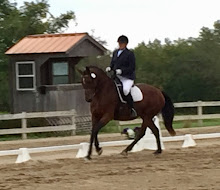Riding inside the muscle of the horse is a concept that is very hard to explain but very worth taking the time to learn how to do. When you ride if your lower body from your hips down is a part of the horse's barrel - a continuation really, then you are in a position to ride inside the horse's muscle.
It takes much more than a quiet seat, it takes blending of the aids to ride inside the horse. The first part of my journey to ride inside of the muscle started at Charles deKunfy clinics. In those clinics we were riding advanced movements , extensions, flying changes, canter pirouettes, and passage with no stirrups. This made me really good at feeling the muscle of the horse and predicting movement as a result of what I was feeling. I will always be grateful for this information. The other thing that was talked about rather at length was isometric stiffness. What that means is controlling the upper body enough that as a rider your upper body was quiet.
Now years later I think I have a better understanding of riding inside the muscle. I think it includes the blending of the lower body being so close to the horse you can feel the muscles changing. The rider must be willing to use the legs to affect lateral balance and understand how to blend the leg aids with torso control and the rein aids.
The key to riding with great feel is to know how to blend the above and what combinations of blending are required to solve what is going on underneath the rider. I wish someone could have explained that to me as a younger rider but I am also thankful for the people who have been giving that information to me over the years in pieces.
Lunge line lessons are a great help and can move that process along faster. Slow down folks and invest in some lunge line lessons. Riding inside the muscle is hard. Performing the advanced dressage movements is way easier. If you want to do it with elegance, work on yourself. Your horse will thank you and ultimately progress faster.
Tuesday, March 15, 2011
Subscribe to:
Post Comments (Atom)

No comments:
Post a Comment
Note: Only a member of this blog may post a comment.